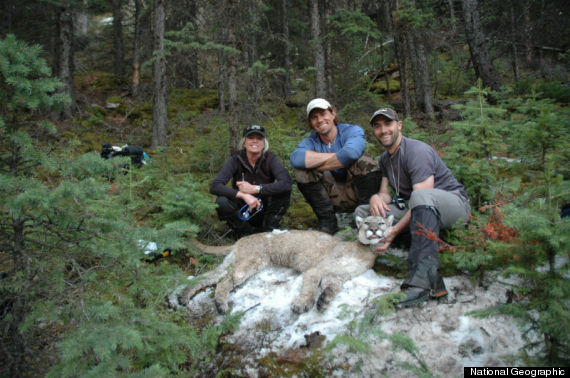/boone-smith/collaring-cougars-in-the-_b_6248618.html
Collaring Cougars
in the Name of
Conservation
Posted: Updated:
A large portion of my capture career has been focused on
mountain lions or cougars as they're also referred to. My
job is really quite simple: Find, track, capture and radio
collar these animals so that scientists can obtain valuable
data to make management and conservations decisions.

The process goes like this: After locating a track, I turn
specially trained hounds loose to scent trail the cougar
and chase it up a tree. The dogs really do the toughest
part of the job; they run with unmatched passion and
excitement, covering endless miles. When I arrive on scene,
I leash the dogs. A tranquilizer dart is quickly loaded, and
the cat is darted. My job then becomes a little tricky. I must
climb the tree, rope up the cougar by the hind legs and
lower it to the ground safely. Animal safety is priority
number one, and despite putting myself in what may
seem like a very dangerous situation, I take it very
seriously and use a lot of common sense. The protocols
for animal tracking are designed to do just that --
keep us all safe. But the wild is not a controlled
environment, and sometimes adapting on the fly is
the name of the game. I have been chased out of trees,
snarled at and swatted at, and I've literally had to
wrestle cats to get the job done. The "rodeo," as I call
it, is what I believe is the best part of my skill set --
making it work when things are not going according
to plan.

When we have the cougar on the ground, we place a
GPS collar on it and gather all kinds of information
(weight, age, blood samples, DNA, measurements, etc.).
We then give the animal a reversal drug to get it up
and on its feet. Animals are fully recovered in less
than an hour. The collar then allows us to learn
information such as movements, habitat use,
predation rates and proximity to other predators
and humans. This data then helps us understand
unique dynamics that exist for specific species in
different regions.

I recognize the capture process is fairly invasive. There is no
doubt that the animal is stressed from our actions and
presence. However, these animals are hardy and tough
and evolved to be very resilient and adaptive. And the means
justifies the end, because the data we get from the collars is
so essential to wildlife conservation. People often tell me we
should just leave these animals alone, and nature will
restore them, but the human footprint is so large and
far-reaching. We have to factor ourselves into the
equation when talking about conservation and management.
So why go to all the effort? Cougars, like all big cats, are
apex predators. Healthy big cat populations help
balance ecosystems and environments. Additionally,
big cats require big spaces. Also, whether we recognize
it or not, we need these wild places with big predators.
Perhaps we don't go there often, but all of us need
that touch of the wild.
Boone Smith-"Big Cat Tracker"
This post is part of a series produced by The
Huffington Post in conjunction with Nat Geo
WILD's Big Cat Week. To see all the other posts
in the series, click here. For more information
about big cats, check out National Geographic's

No comments:
Post a Comment